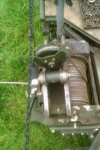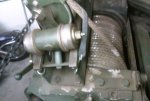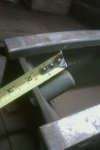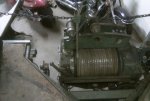- 1,046
- 46
- 48
- Location
- Syracuse, New York
Difference between high speed and low speed driveshaft.
My Braden LU2 spec sheet states the max input speed is 500rpm. I'd guess the std operating speed at about half that. If that's so a 250rpm shaft turns only 4.166 times a second. For a comparison, my stock 40+ year old GTO's driveshaft is turning 5700rpm at 145mph (same as redline in 3rd gear as the trans is 1:1). That works out to 95 times a second. It is also transmitting over 650HP (when on N2o).
p.s. Image below is .pdf.
p.s.s Another comparison useful to grasp the effect that high speed shafts have - The sheet has the LU2's static input torque is 1690in*lbs at rated load (140.8 ft*lbs) . Since HP=T x rpm/5252 the LU2 driveshaft transmits .22HP at max load and max input speed.
(compare that to the 650+hp/700+ lb*ft of the Goat).
p.p.p.s -.22HP - explains why the MV engine rpm stays about the same (when load picks up), even at the incredibly low HP the engine makes at idle.
My Braden LU2 spec sheet states the max input speed is 500rpm. I'd guess the std operating speed at about half that. If that's so a 250rpm shaft turns only 4.166 times a second. For a comparison, my stock 40+ year old GTO's driveshaft is turning 5700rpm at 145mph (same as redline in 3rd gear as the trans is 1:1). That works out to 95 times a second. It is also transmitting over 650HP (when on N2o).
p.s. Image below is .pdf.
p.s.s Another comparison useful to grasp the effect that high speed shafts have - The sheet has the LU2's static input torque is 1690in*lbs at rated load (140.8 ft*lbs) . Since HP=T x rpm/5252 the LU2 driveshaft transmits .22HP at max load and max input speed.
(compare that to the 650+hp/700+ lb*ft of the Goat).
p.p.p.s -.22HP - explains why the MV engine rpm stays about the same (when load picks up), even at the incredibly low HP the engine makes at idle.
Attachments
-
139.5 KB Views: 24
Last edited:





